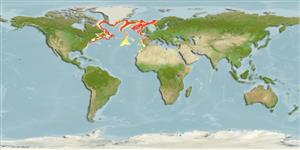Classification / Names
Common names from other countries
Main reference
Size / Weight / Age
Max length : 110 cm TL male/unsexed; (Ref. 35388); max. published weight: 1.7 kg (Ref. 40637); max. reported age: 54 years (Ref. 41452)
Length at first maturity
Lm 52.7, range 60 - ? cm
Environment
Marine; bathypelagic; depth range 180 - 2600 m (Ref. 58426), usually 400 - 1200 m (Ref. 1371)
Climate / Range
Deep-water, preferred 8°C (Ref. 107945); 66°N - 20°N, 77°W - 12°E
Distribution
North Atlantic: from about 37°N to Baffin Island and Greenland in the western Atlantic, and off Iceland and Norway south to North Africa in the eastern Atlantic. Reported to occur from the tongue of the Ocean east of Andros Islands (about 24°N, 77°W) in the Bahamas.
Countries | FAO areas | Ecosystems | Occurrences | Introductions
Short description
Dorsal
spines
(total): 2;
Anal
spines: 0. Head broad, rather soft; snout broad, rounded, with a large blunt tubercular scute at its tip; chin with small barbel. Scales relatively adherent; spinules dense on body scales, long, thin and recurved, narrowly lanceolate, with longitudinal anterior concavity. Pyloric caeca 29 to 31, long and slender. Color medium brown to grayish; orbits, oral and branchial cavities, and fins blackish to brownish gray.
IUCN Red List Status (Ref. 115185)
Threat to humans
Harmless
Human uses
Fisheries: commercial
Tools
Special reports
Download XML
Internet sources
Estimates of some properties based on models
Phylogenetic diversity index
PD50 = 0.5000 many relatives (e.g. carps) 0.5 - 2.0 few relatives (e.g. lungfishes)
Trophic Level
3.5 ±0.49 se; Based on food items.
Resilience
Very Low, minimum population doubling time more than 14 years (K=0.1; tm=9-11; tmax=54; Fec=10,000)
Vulnerability
High to very high vulnerability (67 of 100)
Price category
